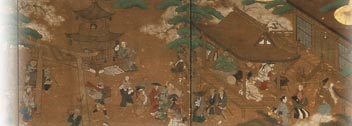Research report session: “The Bunraku film ‘Marionnettes japonaises’”
Outline
| date | Tuesday, December 22, 2009 13:00 – 16:15 |
|---|---|
| Venue | Ono auditorium, Waseda University |
| Organizer | Japanese Theatre Studies Course / Film Studies Course |
| outline | Research report session: “The Bunraku film ‘Marionnettes japonaises’” |
Details
In the academic year of 2009, the Theatre Museum Global COE program acquired (purchased) three reels of film on Bunraku entitled “Marionnettes japonaises” owned by the Musée Albert Kahn in Paris, France. The Japanese Theatre Studies Course and Film Studies Course jointly set up a Bunraku film project (UCHIYAMA Mikiko and SAKURAI from Japanese Theatre Studies Course and TAKEDA Kiyoshi and KOMATSU Hiroshi from the Film Studies Course) to study the film, enter into negotiations leading up to its purchase, and then to digitize the images. Only half a year has passed since its purchase, and research is still in progress, but because this is a film that we hope not only researchers but a broad general audience might see, we held a research report session including a screening of the film and reported on our research findings thus far.First, Professor TAKEDA Kiyoshi, who was in charge of the negotiations with the Kahn museum, gave a report entitled “The Bunraku film and the Musée Albert Kahn.” After locating the museum (founded in 1986) in a Parisian suburb using Google Maps and giving an account of the personality and achievements of the owner of the collection, Albert Kahn (1860–1940), Professor TAKEDA related in detail the circumstances that led up to the purchase of this film.
Next, Professor KOMATSU Hiroshi reported on the historical importance of the Bunraku film from the standpoint of the early history of film in Japan. After describing the present situation in which documentary films have come to be so important for film history studies in recent years that in 2003 a French film journal devoted a special issue to Kahn, Professor KOMATSU made a detailed analysis of the accounts that appeared in film journals primarily in France and Japan.
SAKURAI then showed the film and gave an explanation. During the 42-minute screening he provided commentary on the people who appear and on the subtitles, which were written in French because the film, of course, had no soundtrack. Most of the film was “Bunrakuza ningyo joruri” (Puppet theatre at the Bunrakuza), a film shown in theatres in 1921. The assumption is that it was later (1927?) reedited; three cuts were reshot at Dotombori in Osaka and then added, as were the French subtitles, before the film was exported to France.
After a fifteen-minute break, Professor UCHIYAMA Mikiko, who was the project leader, gave a talk from the standpoint of the history of Bunraku entitled “What can be seen from the Bunraku film.” The 1920s were a major turning point for Bunraku as a result of changes in performance format and a generational shift among the performers. She spoke of the significance – and pleasure – of being able to see moving pictures of YOSHIDA Eiza I, YOSHIDA Bungoro, and YOSHIDA Bunzo as well as of the legendary shamisen master, TSURUZAWA Seiroku III.
Then Mr. KIKUCHI Akira, director of the Shoyo Society, made a guest appearance and discussed his recollections of the art of YOSHIDA Eiza I (d. 1945), whom he had seen in 1942 or 1943. The second half took the form of a conversation between Mr. KIKUCHI and Professor UCHIYAMA in which topics ranged from differences in the artistry of Eiza and Bungoro to the gidayu reciter TOYOTAKE Yamashiro no Shojo.
After Mr. KIKUCHI left, SAKURAI joined Professor UCHIYAMA to discuss part of Princess Yaegaki’s kudoki (lamentation) in the “Jushuko no dan (Ten Types of Incense)” scene (reel two) in which the sequence has been reversed; a version of this section only was then shown in which the proper sequence has been restored. In addition, an excerpt from the michiyuki (travel dance) from “Imoseyama” was shown in which, as an experiment, the film was synchronized to sound from an SP record that had been recorded and sold at almost the same time that the film had been made. Unlike the time when the silent film was shown, the moment when the performance of 88 years ago was vividly recreated through the addition of a contemporary sound track was very exciting. At the same time it was quite obvious that the basic gestures and movements of Bunraku today remain completely unchanged. Although one might think intellectually that this would be only natural in the case of a traditional performing art, this time it was actually confirmed both visually and aurally.
This film is without doubt the oldest and the longest of the films on Bunraku that exist today. The reports in this session were on research in progress, and we look forward to further advances being made from the twin perspectives of theatre (Bunraku) and film. As soon as preparations at the Theatre Museum are complete, plans are underway to make it available as an audio-visual service at AV booths. We therefore very much hope that those people who were unable to attend this session will take the opportunity to see the film. Announcements of the research report session were published prior to the event in newspapers such as the Asahi Shimbun, Yomiuri Shimbun, Mainichi Shimbun, Tokyo Shimbun and Kyodo News Service, and an article on the session with photographs was subsequently published in the Yomiuri Shimbun. In addition, the discovery of the Bunraku film was cited as one of the topics of the year on the NHK TV program “Geino Hana Butai” (Great classic performances) for December 24, and a part of the film was introduced.


